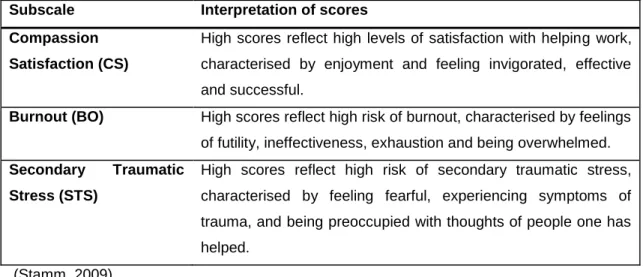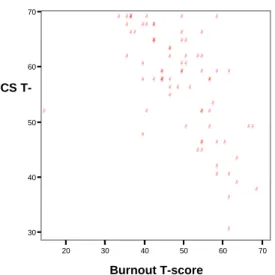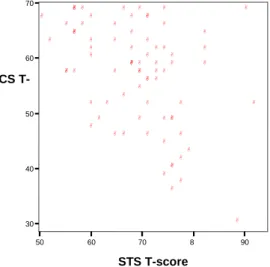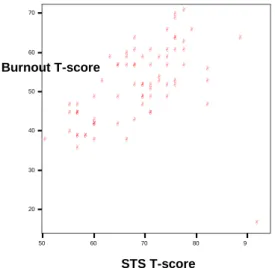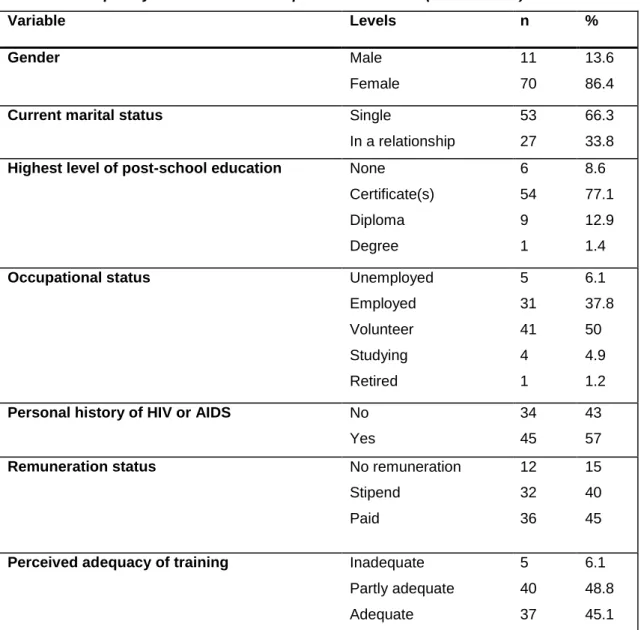This study examined levels of compassion fatigue, burnout, and compassion satisfaction among caregivers and examined the relationship between these and caregivers. Compassion Satisfaction was negatively correlated with burnout and secondary traumatic stress, while burnout was positively correlated with secondary traumatic stress.
INTRODUCTION TO THE STUDY
- Introduction
- Theoretical background for the study
- Motivation for the study
- Significance of the study
- Summary
The researcher worked for some time as a volunteer at a non-governmental organization (NGO) that deals with HIV and AIDS. Although community care programs rely heavily on volunteer caregivers, little research has been done on compassion fatigue and burnout among HIV/AIDS volunteers (Miller, 2000).
REVIEW OF LITERATURE
Introduction
Theories of compassion fatigue, compassion satisfaction and burnout
- Compassion fatigue
- Compassion satisfaction
- Burnout
Many writers consider the terms STS and compassion fatigue to be interchangeable (eg Deighton et al., 2007; Figley, 1995). In the field of nursing, it has been noted that levels of burnout and compassion fatigue have increased dramatically in the presence of the HIV/AIDS epidemic.
HIV and AIDS in KwaZulu-Natal
Thus, it appears that the phenomenon of burnout is necessarily contextually embedded; that is, it is defined by the prevailing values and motives of the context as well as those who experience it. In addition, the rapid development of transport infrastructure in recent years has facilitated much greater freedom of movement for people as well as goods, and thus also the spread of HIV (Quinn, 1985, cited in Lurie et al., 2003).
Challenges of caring for people infected and affected by HIV
Mental health problems tend to be overrepresented among people with HIV due to associations between mental illness or substance abuse and HIV-related risk behaviors (Cournos & Collins, 2003; Freeman, Patel, Collins & Bertolote, 2005). As a result, much of the responsibility for the sick is borne by family and community carers who work "in isolation in private homes" (Thabethe, 2006, p. 104).
Caregivers
Home care appears to be a more "realistic" or "affordable" option because its true costs are hidden, returning to the domestic areas of the poor. Of the 10 participants in the study conducted by Thabethe (aged between 22 and 44), seven had left school before completion due to economic hardship, eight had never been employed and the remaining two had previously been domestic workers (Thabethe, 2006 ).
Sources of vulnerability for caregivers
Stigma is defined as a “process of devaluation” in which the characteristics of the stigmatized person are considered “discreditable or unworthy,” which then results in the person being marginalized or viewed as infected (Goffman, 1964, cited in Thomas, 2006, p. 3175) . In the context of these high levels of perceived stigma, home caregivers may find themselves stigmatized by association—a process known as social contagion (Horsman & Sheeran, 1995, cited in Miller, 2000) or secondary stigma (Armstrong, 2000; Miller). , 2000).
Possible mediating factors
Supervision has been identified as a very important facilitating factor for caregivers (Rudolph, Stamm & Stamm, 1997; Uys, 2002). Lack of material resources (including transportation) has been identified as a source of significant frustration for healthcare providers (Richter et al., 1999; Stamm et al., 2002; UNAIDS, 2008).
Summary
METHODOLOGY
- Introduction
- Aims and objectives
- Research questions
- Research design
- Sampling
- Instruments
- Procedure
- Ethical considerations
- Data analysis
- Summary
This measure is the current version of the Compassion Fatigue Self Test developed in the 1980s by Figley (Stamm, 2009). For this research, the ProQOL was also made available in Zulu, as it was expected that this would be the first language of many of the participants. The researcher arranged to do data collection at the usual meeting rooms of the respective groups in Mpophomeni, Lidgetton and Howick.
Subsequently, descriptive statistics for the dataset were generated and the respondents' scores were compared to those of the reference norm group. These include the ProQOL subscale scores and some demographics such as age and caseload of caregivers. Details of the sampling, the instruments used and the procedure followed in data collection are given.
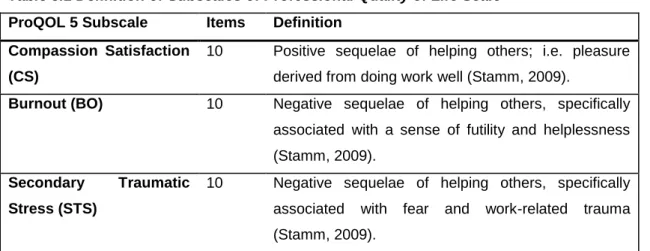
RESULTS
Introduction
The Professional Quality of Life Scale (ProQOL)
The mean score for burnout was 50.8 (SD = 9.60), corresponding to the 50th percentile of the reference group. The majority of respondents (55.1%) scored above the reference norm group mean for this subscale, with 28.2% scoring above the 75th percentile (see Table 4.3 below). This indicates that, although the group mean score for this subscale is close to the reference mean, a significant proportion of respondents have a relatively high risk of burnout.
The mean score for Secondary Traumatic Stress was 69.9 (SD = 8.78), corresponding to the 95th percentile of the reference group. The overwhelming majority (93.7%) of the respondents scored above the cut-off point for the 75th percentile, as shown in Table 4.4 below. This suggests that most participants in this study are at relatively high risk of Secondary Traumatic Stress as a result of their work as caregivers.

Personal attributes
The caregivers who indicated that they were certain of their roles had significantly lower levels of Secondary Traumatic Stress than their counterparts who demonstrated some uncertainty and frequent uncertainty (see Figure 4.22). Caregivers who were unsure whether they were doing their job well had significantly higher levels of Secondary Traumatic Stress than those who thought they were doing a good job (see Figure 4.24 below). Those who experienced no stigma as a result of their work had significantly higher levels of compassion satisfaction than those who sometimes experienced stigma (Figure 2.26 below).
Caregivers who reported consistent social support had significantly lower levels of burnout than those who did not (see Figure 4.30). Caregivers who reported consistent support from those close to them had significantly lower levels of secondary traumatic stress than those who received only occasional support and those who did not (see Figure 4.31). Caregivers who regularly engaged in self-care had significantly lower levels of secondary traumatic stress than those who rarely or never did so (see Figure 4.34 below).
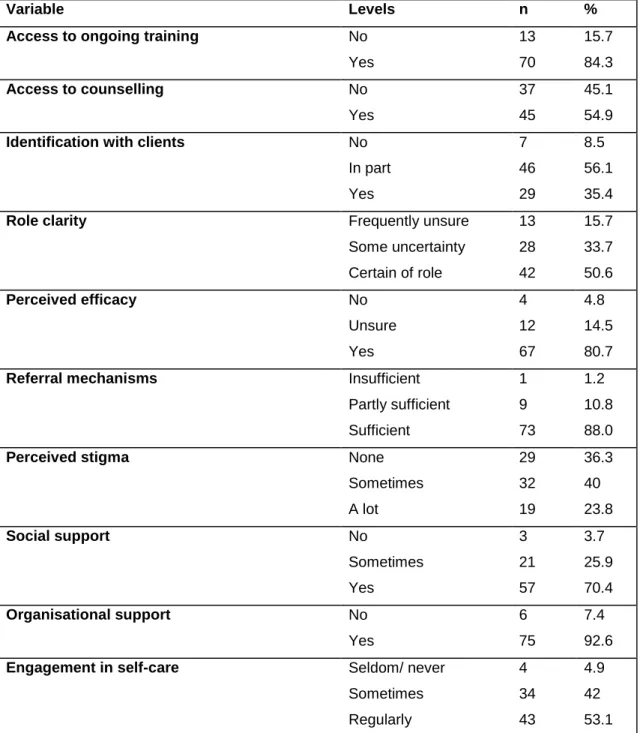
Summary
It was found that the average scores of the respondents on the dependent variables, namely compassion, satisfaction, burnout and secondary traumatic stress, corresponded to the 73rd, 50th and 95th percentiles of the reference norm group. This indicates a general pattern of relatively high compassion satisfaction, average levels of burnout, and very high levels of secondary traumatic stress among respondents. In the case of compassion satisfaction, there were highly significant negative correlations with burnout, r p < 0.0005, and secondary traumatic stress, r(76).
Significant differences in levels of Compassion Satisfaction were found at different levels of the following independent variables: (1) gender; (2) role clarity; (3) perceived effectiveness; (4) secondary stigma; and (5) social support. Statistically significant differences in mean levels of burnout were found at different levels of the following independent variables: (1) gender, (2) role clarity, (3) secondary stigma, and (4) social support. In addition to the above correlations, significant differences were found in levels of secondary traumatic stress at different levels of the following independent variables: (1) personal history of HIV or AIDS; (2) access to counseling or therapy; (3) role clarity; (4) perceived effectiveness; (5) secondary stigma; (6) social support (7) organizational support; and (8) self-care.
DISCUSSION
- Introduction
- Demographic profile of caregivers
- Significant effects
- Limitations and shortcomings of the study
- Summary
However, most respondents reported only three weeks of training, and more than half said they felt the need to increase their knowledge in light of the demands of their job. These correlations are much stronger than those reported in the test manual, suggesting an effect specific to this study rather than due to the construction of the measure. With regard to role clarity, the results of this study indicate that certainty of the scope and boundaries of the caregiver's role is associated with lower levels of burnout and secondary traumatic stress, and higher levels of compassion satisfaction.
An examination of the frequency distribution reveals that almost half of the respondents (49.4%) indicated that they felt uncertain about the boundaries of their roles to some extent. Gender had significant effects on both of the above aspects of quality of professional life. As noted, as a result of the gender imbalance among caregivers, the overall number of male participants in this study was quite low.
CONCLUSIONS AND RECOMMENDATIONS
- Introduction
- Equity and sustainability
- Secondary traumatic stress/ compassion fatigue
- Burnout
- Compassion satisfaction
- Role clarity
- Secondary stigma
- Male caregivers
- Organisational considerations
It is recommended that programs be developed and implemented to prevent compassion fatigue and burnout among relatives. A view of HIV/AIDS and mental health problems in South Africa – from the outside looking in. Figley (Ed.), Compassion fatigue: Coping with secondary traumatic stress disorder in those who treat the traumatized, pp.1-20.
Figley (Ed.), Compassion fatigue: Coping with secondary traumatic stress in those who treat the traumatized (pp. 150-177). Retrieved May 7, 2010, from http://www.kff.org/southafrica/upload/Hitting-Home-How-Households-Cope-with-the-Impact-of-the-HIV-AIDS-Epidemic-Report.pdf . Figley (Ed.), Compassion fatigue: Coping with secondary traumatic stress disorder in those who treat the traumatized, pp.
Item analysis of the Professional Quality of Life Scale
I avoid certain activities or situations because they remind me of painful experiences of the people I help.
Database of factors that research suggests may be associated
Traumatic Memories - When clients recall experiences with other clients associated with emotional response. Dissatisfaction with education/lack of education/perceived inadequacy of education (Bennett, Ross & Sunderland, 1996; Guinan et al., 1991) The sense of need (risk factor). Motivation – can lead to a greater sense of reward AND greater vulnerability to negative psychological outcomes.
Role insufficiency (Inadequate supplies, equipment and/or information ie resources – ie positive correlation with emotional exhaustion) Relationships with superiors and colleagues. Age – negative correlation (Dutton & Rubenstein, cited in Figley, 1995) Social and family relationships (ie social support). Lack of effective voice in decisions affecting them and their work Inadequate support, supervision and recognition.
Informed consent (English version)
The signed consents will be stored separately from the questionnaires in a secure place where only the researcher will have access. After reading this form, please ask the researcher any questions you may have about participating in this research. Once you feel that you understand what participation will mean for you, you can decide whether or not you want to enroll in this study.
Uma usuqedile ukufunda leli fomu, sicela ukhululeke ukubuza umcwaningi noma imiphi imibuzo ongase ube nayo ngokuba yingxenye yalolu cwaningo. Uma uzwa sengathi uyazi/uyaqonda ukuthi kusho ukuthini ngawe ukuba yingxenye yalolu cwaningo, unganquma ukuthi uyafuna yini ukuba yingxenye yocwaningo noma cha. Ngiyazi ukuthi nginelungelo lokuyeka ukuhlanganyela kulolu cwaningo nganoma yisiphi isikhathi phakathi nocwaningo, ngaphandle uma kunemiphumela emibi.
Questionnaires (English versions)
I avoid certain activities or situations because they remind me of the frightening experiences of the people I help. Do you feel that your training adequately prepared you for the work you do now as a carer? Are you ever confused about which responsibilities are part of your job as a caregiver and which are not?
If clients need help with things that are not part of your job as a caregiver, are you able to refer them to someone who can help them? Do you feel that you are stigmatized by other people because of your work with people who have HIV or AIDS? Is there a person (or people) within your organization who gives you help and advice about your work with clients.
Group statistics
Correlation matrix
